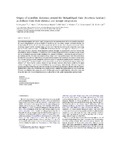| dc.contributor.author | Ringrose, S. | |
| dc.contributor.author | Harris, C. | |
| dc.contributor.author | Huntsman-Mapila, P. | |
| dc.contributor.author | Vink, B.W. | |
| dc.contributor.author | Diskins, S. | |
| dc.contributor.author | Vanderpost, C. | |
| dc.contributor.author | Matheson, W. | |
| dc.date.accessioned | 2010-07-23T13:07:15Z | |
| dc.date.available | 2010-07-23T13:07:15Z | |
| dc.date.issued | 2009 | |
| dc.identifier.citation | Ringrose, S. et al (2009) Origins of strandline duricrusts around the Makgadikgadi Pans (Botswana Kalahari) as deduced from their chemical and isotope composition, Sedimentary Geology, Vol. 219, pp. 262–279 | en_US |
| dc.identifier.issn | 0037-0738 | |
| dc.identifier.uri | http://hdl.handle.net/10311/560 | |
| dc.description.abstract | Trace elements togetherwith some O and C isotope analysiswere undertaken on duricrust strandline deposits in
the palaeo-Makgadikgadi sub-basin (PMSB) to provide insight into palaeo-climatic conditions through the
interpretation of calcrete, silcrete–calcrete intergrade and silcrete deposits. Trace element content and relative
abundance suggest that the duricrust origins are associated with the long-term weathering of the Karoo Large
Igneous Province which underlies the PMSB. This work shows that duricrust origins are related to Ca2+ and Si
(and associated trace elements) being transported mainly through the groundwater and then subsequently
precipitated at different strandline elevations over time. Local groundwater feeding in towards the pan margin
and accumulating in near-neutral pan-marginal pools, appears to facilitate Si concentration and permeation of
pre-existing calcretes. The silica precipitates as the pH drops when renewed freshwater enters the pools. Hence
the inferred palaeo-climatic regime for silcretisationmay be similar to that occurring in Botswana at present being
dry semi-arid with lowseasonal rainfall. In contrast the extensive calcrete precipitation in the strandlines results
from abundant Ca2+ in adjacent waters which appear to be derived from both local and regional sources. The
arrival of Ca2+ from regional sources (shown by trace element evidence) infers heavy rainfall in the upper
catchment suggesting a major humid event followed by regional drying. Palaeo-climatic inferences suggest the
juxtaposition ofmajor humid events interspersedwithmore normal semi-arid palaeo-climateswith an exception
obtained from isotope data, of drier and cooler conditions than usual for the region around 80–90000 years ago.
Whereas trace element data can greatly assist in the interpretation of complex deposits such as duricrusts, care
should be taken over the use of particular ratios (such as Yb/Gd ratio) which may produce spurious results. | en_US |
| dc.language.iso | en | en_US |
| dc.publisher | Elsevier www.elsevier.com/locate/sedgeo | en_US |
| dc.subject | Kalahari duricrusts | en_US |
| dc.subject | Calcretisation | en_US |
| dc.subject | Silcretisation | en_US |
| dc.subject | Silcrete–calcrete intergrade deposits | en_US |
| dc.subject | Palaeo-climatic change | en_US |
| dc.title | Origins of strandline duricrusts around the Makgadikgadi Pans (Botswana Kalahari) as deduced from their chemical and isotope composition | en_US |
| dc.type | Published Article | en_US |

